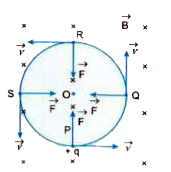Consider the motion of a charged particle of mass m and charge q moving with velocity →v in a magnitude field →B. If →v is perpendicular to →B, show that it describe a circular path having angular frequency ω=qBm
When a charged particle having charge q and moving with a velocity →v enters a uniform magnetic field →B, it experiences a Lorentz force →F=q(→v×→B) whose direction is given by Fleming.s left hand rule. The force is maximum when charged particle is moving perpendicular to the magnetic field. In that case
F=qvBsin90∘=qvB
As the force is acting perpendicular to both →vand→B, it does not change the magnitude of velocity but changes its direction from a straight from a straight line path to a circular path of radius r such that the magnetic force - centripetal force needed.
∴Bqv=mv2r⇒r=mvBq
The time period and frequency of the charged particle in its circular path will be
T=2πrv=2π(mvBq)v=2πmBq, Frequency v=1T=Bq2πm
and angular frequency ω=2πv=qBm.
From this relation it is clear that the time period (as well as frequency) is independent of the velocity (energy) of the charged particle as well as the radius of the circular path.

Topper's Solved these Questions
- MOVING CHARGES AND MAGNETISM BOOK - U-LIKE SERIESCHAPTER - MOVING CHARGES AND MAGNETISM EXERCISE - LONG ANSWER QUESTIONS-II
11 Videos
- MOVING CHARGES AND MAGNETISM BOOK - U-LIKE SERIESCHAPTER - MOVING CHARGES AND MAGNETISM EXERCISE - SELF ASSESSMENT TEST (SECTION A) (MULTIPLE CHOICE QUESTIONS)
5 Videos
- MOVING CHARGES AND MAGNETISM BOOK - U-LIKE SERIESCHAPTER - MOVING CHARGES AND MAGNETISM EXERCISE - SHORT ANSWER QUESTIONS
41 Videos
- MODEL TEST PAPER 3 (UNSOLVED)BOOK - U-LIKE SERIESCHAPTER - MODEL TEST PAPER 3 (UNSOLVED)EXERCISE - SECTION A
3 Videos
- NUCLEIBOOK - U-LIKE SERIESCHAPTER - NUCLEIEXERCISE - Self Assessment Test
10 Videos
Similar Questions
What is the direction of the force acting on a charged. Particle q moving with a velocity →v in a uniform magnetic field →B ?
View Solution(a) Write the expression for the force →F acting on a particle of mass m and charge q moving with velocity →v in a magnetic field →B. Under what conditions will it move in (a) a circular path and (ii) a hetical path?
View Solution
Knowledge Check
A particle of mass m, charge e and velocity v moving in a magnetic field B perpendicular to the motion of particle. The radius of its path is:
ABemvBevBmCBvemDmvBeA charged particle moves with a velocity →v in a uniform magnetic field →B. The magnetic force experienced by the particle is
Aalways zeroBzero if →v and →B are perpendicularCnever zeroDzero if →v and →B are parallel or antiparallel.A particle of mass m and charge q enters a magnetic field B perpendicularly with a velocity v, The radius of the circular path described by it will be
ABq/mvBmq/BvCmB/qvDmv/Bq
Answer the following:
(a) Write the expression for the force →F acting on a particle of mass m and charge q moving with velocity→V in a magnetic field →B . Under what conditions will it move in
(i) a circular path and (ii) a helical path ?
(b) Show that the kinetic energy of the particle moving a magnetic field remains constant.
View SolutionA point charge q moving with a velocity →v at a given time in a magnetic field →B experiences a force given as F=q[→v.→B]
View Solution(a) Write the expression for the force →F acting on a particle of mass m and charge q moving with velocity →v in a magnetic field →B. Under what conditions will it move in (i) a circular path and (ii) a helical path?
(b) Show that the kinetic enery of the particle moving in magnetic field remains constant.
View SolutionA charged particle of unit mass and unit charge moves with velocity →v=(8ˆi+6ˆj)ms−1 in magnetic field of →B=2ˆkT. Choose the correct alternative (s).
View SolutionA charged particle of unit mass and unit charge moves with velocity →v=(8ˆi+6ˆj)ms−1 in magnetic field of →B=2ˆkT. Choose the correct alternative (s).
View Solution
